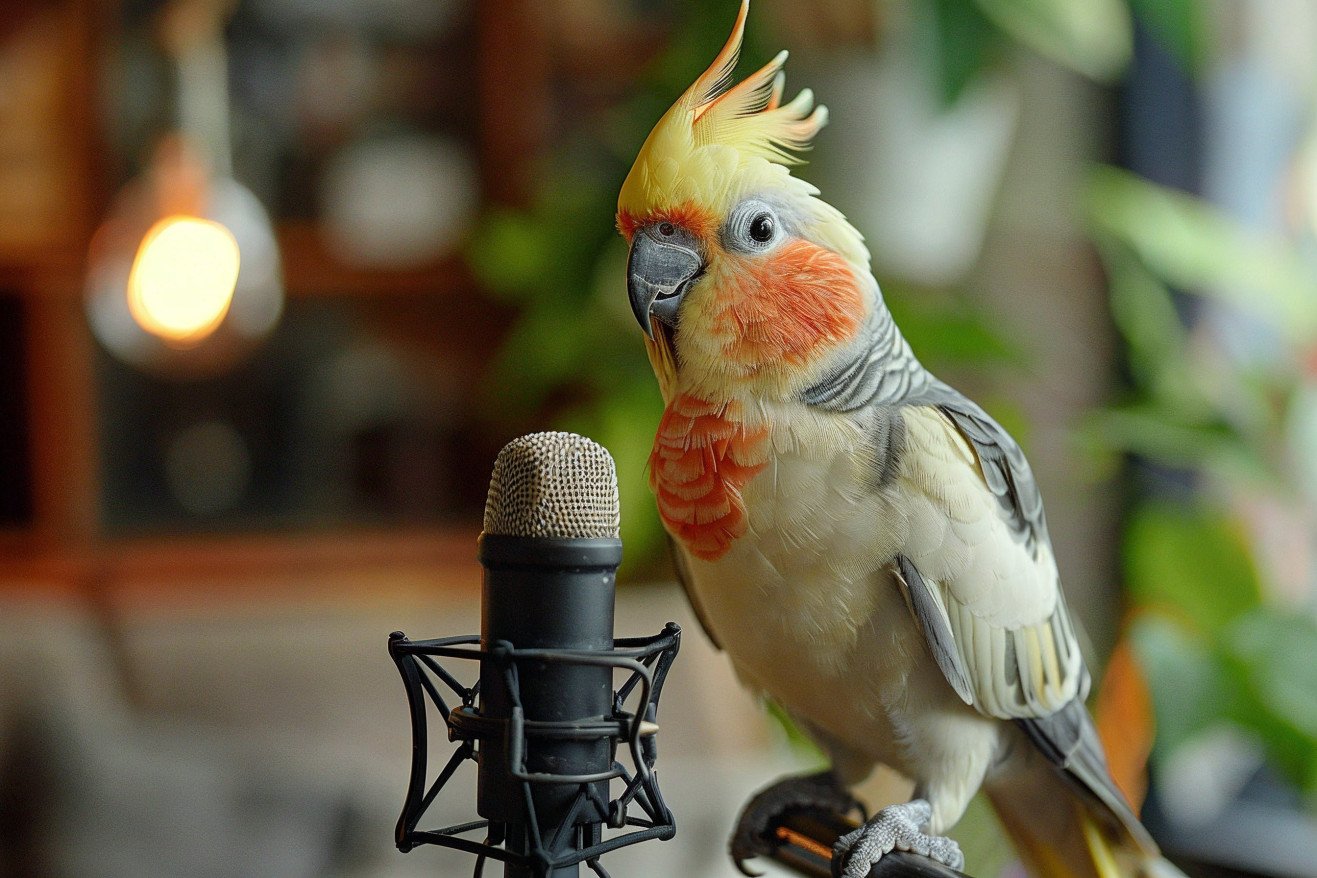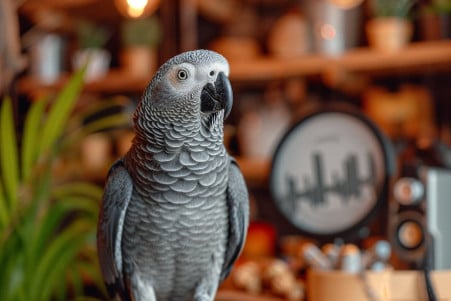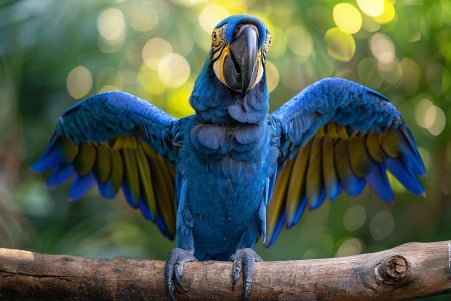Do Cockatiels Talk? What to Know About Their Speech Mimicry
4 March 2024 • Updated 4 March 2024

Cockatiels are known for their beautiful songs, but can they actually mimic human speech? The answer is yes, cockatiels can talk and mimic human speech, although it’s more common in males than females. They can be taught to talk and mimic words and phrases through repetition and positive reinforcement.
While their capacity for speech is less advanced than that of larger parrots, with practice, they can learn to say a variety of words and even short songs.
This article will explore a wide range of interdisciplinary studies from the fields of ornithology, avian psychology, and comparative linguistics. It will primarily focus on scientific research that has investigated cockatiels’ vocal learning, the physiological mechanisms that underlie their speech mimicry, and the social and environmental conditions that facilitate their ability to communicate in a way that’s similar to humans.
By the end of the article, you will have a thorough understanding of the factors that enable these lovable birds to mimic human speech.
Do cockatiels talk?
Tweet Talk: Exploring Cockatiel Speech Mimicry
In addition to their beautiful plumage, cockatiels are known for their vocalizations. They can make a variety of sounds, from musical whistles to attempts at human speech. According to Psittacology, males are more likely to make complex sounds to attract mates, while females tend to make simpler flock calls. However, their ability to mimic human speech and other sounds is often characterized by a harsh, gravelly quality and limited to short phrases.
A number of factors can influence a cockatiel’s ability to mimic sounds. Genetics, age, and personality all play a role, according to Wings & Whistle. In general, younger birds, especially those that are hand-fed, are more likely to learn to talk. This period of time when they are most likely to learn is also the most important time for a bird owner to work with their pet to help them develop their talking skills.
Like people, each cockatiel is an individual, and that individuality is reflected in their ability to mimic sounds. According to Beauty of Birds, while some cockatiels may have a vocabulary of up to 90 words, others may never learn to make a single human-like sound, even with consistent training. It’s important to have realistic expectations.
Not every cockatiel will be a talker, but with patience and understanding, their vocalizations can still be an important part of the bond between a person and their pet.
Understanding the Science of Cockatiel Speech Mimicry
The cognitive underpinnings of cockatiel speech mimicry are complex and involve advanced auditory learning and socialization. Cockatiels, along with other talking birds, are social learners, meaning they learn by listening to and copying the vocalizations of their parents or other caregivers, according to the Nature Blog Network. This tradition of mimicry is more than just repeating sounds, it’s a sophisticated form of sound learning that’s honed through practice.
While cockatiels aren’t as intelligent as larger parrots like African Greys, they still have the same impressive ability to mimic sounds that’s found in other talking birds. Their exposure to human speech and the way their environment is set up play a big role in their vocal learning, according to a study in PMC. Just like corvids and parrots, cockatiels show that they learn through observation and socialization.
In fact, many trainers use positive reinforcement-based techniques to help cockatiels learn to mimic speech, which is similar to the way these birds would learn to talk in the wild. Early socialization, interactive training sessions, and a supportive environment are all important in helping a cockatiel learn to mimic human speech.
And the learning never stops. As we learn more about the social and cognitive aspects of speech mimicry, we also come to appreciate the physical processes that make it all possible.
The Biology of Birdsong: How Cockatiels Imitate Human Speech
Cockatiels’ ability to mimic human speech is made possible by a highly specialized vocal organ known as the syrinx. The syrinx is located at the tracheal bifurcation (where the trachea splits into the lungs) and is a unique avian structure. Unlike the human larynx, which contains vocal cords, the syrinx is a complex array of muscles that enable a wide variety of sounds.
A study in the Journal of The Royal Society Interface found that the avian vocal tract’s shape directly impacts sound production, indicating that birds, including cockatiels, have the ability to modify their calls.
The syrinx’s location at the base of the trachea, as proposed in a study published in PMC, may have played a role in its evolution, allowing it to be more acoustically efficient. This location enables upstream resonance, which gives birds a wide vocal range and the ability to produce two different sounds at the same time, one from each side of the syrinx.
Cockatiels and other birds can adjust the syrinx and vocal tract, including the oropharyngeal-esophageal cavity (OEC) volume, to change the quality and pitch of their sounds, as described in the study above. This ability to change the geometry of the vocal tract helps cockatiels imitate human speech, although they are still limited by their anatomy.
Knowing the anatomical and physiological details of cockatiel vocal mechanisms helps us appreciate the evolutionary wonders of avian communication and sets the stage for understanding how social and environmental influences play a role in their vocal learning.
The Social Orchestra: Social Learning and the Social Environment
The social environment in which a cockatiel is raised has a huge impact on its ability to learn to talk. Studies, including one by Dr. Michael D. Beecher on song sparrows, have shown that the vocalizations of cockatiels are learned not only through vocal imitation but also through the social interactions that take place within the flock.
Both direct and indirect social interactions contribute to the variety of sounds that young cockatiels are exposed to and can then imitate.
A supportive training environment and the involvement of the owner are key to helping a cockatiel develop its vocal skills. As noted in Learning & Behavior, cockatiels learn best in an environment that includes social interactions that can help reinforce the desirability of certain vocalizations.
This is especially true when one looks at the role of socialization and the social environment in the vocal learning of birds, as outlined in Philosophical Transactions of the Royal Society B. Factors such as social gregariousness and the use of song for communication have been shown to predict a bird species’ ability to learn vocally.
Moreover, a study published in Frontiers in Psychology shows that feedback is important in helping to shape vocal learning.
Cockatiels are more likely to practice and repeat sounds if they receive positive feedback that is given immediately.
On the other hand, a lack of social interaction or a negative social environment can lead to a lack of willingness to engage in vocal imitation. As a result, the social interactions that take place within a cockatiel flock are important for individual learning, which shows that a supportive and socially rich environment is necessary to help enhance a cockatiel’s natural inclination to learn to talk.
How to Encourage Cockatiel Sounds and Vocalizations
In order to encourage cockatiels to reach their full vocal potential, it’s important to make sure that they are in an environment that encourages growth.
According to wikiHow, mental stimulation can be encouraged through toys like shredding toys, swings, and mirrors that will cater to their naturally inquisitive minds. By rotating these toys often, you can keep your bird from getting bored and encourage them to think, which will help them with their mimicry.
Social interaction is also key to the well-being of cockatiels, and BirdTricks notes that training and playtime are important for mental stimulation. Not only will this help you bond with your bird, but it will also help them learn how to speak. Playing games like fetch and teaching them tricks will help them learn to focus and listen, which is important for vocal training.
PetMD notes that a proper environment is also important, and this means keeping them away from toxic fumes and giving them a variety of perches to help stimulate their minds. In addition, it’s important to make sure that your bird is getting enough UV light to stay healthy, which will also help them stay engaged in learning activities, including learning to talk.
By making sure that these needs are met, you can help your cockatiel learn to mimic speech. A well-cared-for bird is a happy, vocal bird that will be able to progress in learning communication and fostering a bond with you.
Final Thoughts: Cockatiel Vocal Mimicry Unveiled
In conclusion, the ability of cockatiels to talk emerges from a complex interplay of genetics, socialization, and care. Although these factors suggest that these social birds are less likely to talk than larger parrots, the reality that they can talk at all is a clear indication of the unique way that these birds communicate.
A cockatiel’s talking ability is influenced by its personality, how it was raised, and the relationship it has with its human family. The cognitive and social factors that come into play, as well as the bird’s environment and the actions of its owners, are the building blocks of the learning process that leads to talking.
Meanwhile, a cockatiel’s anatomy, including its syrinx, makes it possible for the bird to manipulate and project its voice, which is necessary for talking.
Understanding the factors that contribute to cockatiels’ talking ability can help us better appreciate their intelligence and social requirements, and in turn, be better pet parents by acknowledging and respecting the full range of what our birds can do.
In the end, let’s appreciate the intricate interplay of communication we have with our cockatiels and work to create an understanding and supportive environment where their voices can be heard.


